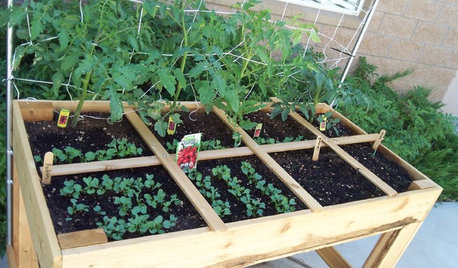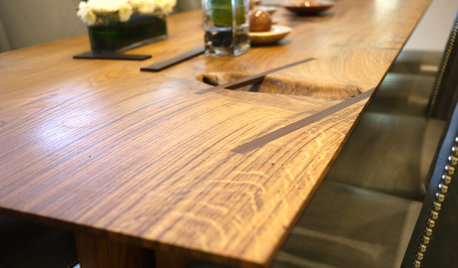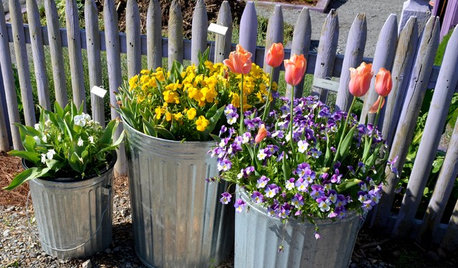First harvest has mites, can I use the compost?
pscan
18 years ago
Featured Answer
Comments (17)
pscan
18 years agolast modified: 9 years agoRelated Discussions
How can I use compost when I already have mulch down?
Comments (17)Every spring I rake away heavy layers of wet, matted leaves that look awful. Not only do they look bad but they suffocate everything underneath them. I have mostly maple, oak and ash...am I doing something wrong? Yes, you are removing the best natural mulch. ;) It is one that is also far more effective than wood chips at keeping down weeds and it replaces itself every year instead of you having to do all the work of replacing the wood chips every year. But if you don't like its looks just put your wood chips on top of it. To plant annuals just move the leaves aside, plant and put the leaves back in place. Any perennials will come up right through the leaves. Leaf mulch doesn't suffocate anything underneath it - instead it feeds whatever is there, stabilizes the soil moisture levels, and blocks the light that the needs need to sprout. Dave...See MoreHarvested Catnip has little bugs....What should i do?
Comments (2)I would just shake the stems to get more bugs out and let the catnip dry until crispy. After the herb is dry put it in an airtight container and stick in the freezer for a day. Lots of people do this with their grains and flours before using, to kill any weevils or moths. You can also submerge your harvested stems in a bucket of cold water to get the bugs out before you dry them, but tiny dried bugs aren't going to hurt your cats...they would probably ingest all kinds of cooties if they were munching on the plant outside, and my cats hunt bugs all the time inside or out....See MoreCan I compost black walnut shavings and safely use the compost?
Comments (11)"The causal agent is a chemical called “juglone” (5 hydroxy-1,4-napthoquinone), which occurs naturally in all parts of the black walnut." "Leaves, bark, or wood chips of black walnut should not be used to mulch sensitive landscape or garden plants. Even after a period of composting, such refuse may release small amounts of juglone." From:Purdue Cooperative Extension I have black walnuts in my yard and I avoid adding any part of the tree to my compost. For me, it just isn't worth the risk. Maybe others have anecdotes to refute this, but I'd proceed with caution if I chose to use any BW in my compost. If anyone has other information, I'd like to see it....See MoreSmelly compost - time to harvest?
Comments (3)"a vermicomposting system with two trays." There seems to be a few trays missing. If you had a third tray I would say fill it with shredded cardboard egg carton and place on top. Then put the bottom tray above it. In a few weeks it will drain and as best as that compost can be it will be....See MorePuffyJBo
18 years agolast modified: 9 years agopscan
18 years agolast modified: 9 years agoPuffyJBo
18 years agolast modified: 9 years agocarnationman
18 years agolast modified: 9 years agojajm4
17 years agolast modified: 9 years agoladymorgahnna
17 years agolast modified: 9 years agofayrehale
15 years agolast modified: 9 years agoJasdip
15 years agolast modified: 9 years agoheatherlorsong_gmai_com
14 years agolast modified: 9 years agosusanfromhawaii
14 years agolast modified: 9 years agorosepetal0415
14 years agolast modified: 9 years agochevere33
14 years agolast modified: 9 years agoacenjason
14 years agolast modified: 9 years agoxoxdanni_hotmail_com
13 years agolast modified: 9 years agosteveinaus
12 years agolast modified: 9 years ago
Related Stories

GARDENING GUIDESGet on a Composting Kick (Hello, Free Fertilizer!)
Quit shelling out for pricey substitutes that aren’t even as good. Here’s how to give your soil the best while lightening your trash load
Full Story
GARDENING GUIDESMaximize Harvests With Square-Foot Gardening
This efficient edible-gardening technique can help people who are short on space
Full Story
GREEN BUILDINGHow to Harvest Rainwater for Your Garden
Conserve a vital resource and save money by collecting stormwater for irrigation in a barrel or tank
Full Story
GARDENING AND LANDSCAPINGWorld of Design: 10 Home Gardeners Show Us Their Sweet Summer Harvests
From New York to Tokyo, these gardeners have turned their yards, terraces and rooftops into places of bounty
Full Story
WOODKnotty and Nice: Highly Textured Wood Has a Modern Revival
Whether it's cedar, fir or pine, if a wood has a knot, it's hot
Full Story
Houzz Gifts: 31 Finds for the Chef Who Has Everything
Delight serious cooks with the latest in kitchen gadgets, accessories, cookware and small appliances from Houzz
Full Story
FURNITUREWood Furniture Has Root Cause
Sustainability is just the beginning with Robin Wade's lovingly made 'rustic modern' wood furnishings
Full Story
GARDENING GUIDES10 Tips to Start a Garden — Can-Do Ideas for Beginners
Green up your landscape even if you're short on time, money and knowledge, with these manageable steps for first-time gardeners
Full Story
BUDGET DECORATINGThe Cure for Houzz Envy: Entryway Touches Anyone Can Do
Make a smashing first impression with just one or two affordable design moves
Full Story
EDIBLE GARDENSSee How a Practical Garden Can Be a Visual Treat, Too
A university edible garden overflows with ideas for growing produce and flowers in containers, beds — or a pickup truck
Full StorySponsored
Columbus Area's Luxury Design Build Firm | 17x Best of Houzz Winner!



Kelly_Slocum